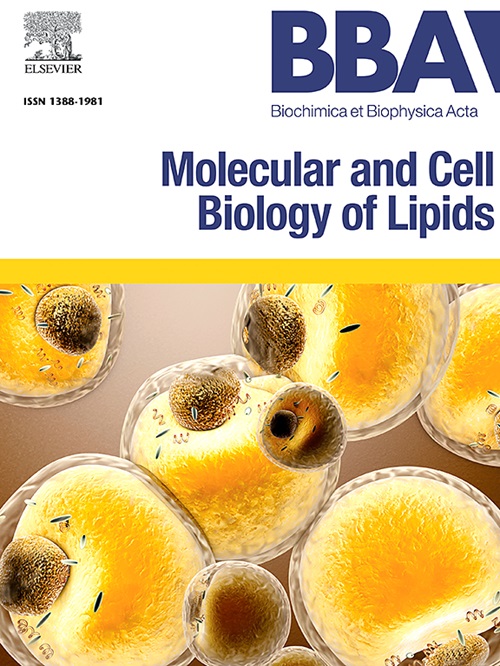一种来自黄竹的天然噻吩(L.)通过增强高脂肪饮食喂养的肥胖小鼠的脂肪细胞产热来对抗肥胖
IF 3.3
2区 生物学
Q2 BIOCHEMISTRY & MOLECULAR BIOLOGY
Biochimica et biophysica acta. Molecular and cell biology of lipids
Pub Date : 2025-06-10
DOI:10.1016/j.bbalip.2025.159644
引用次数: 0
摘要
全球肥胖率的上升已成为一个严重的公共卫生问题。近年来的研究表明,从药用植物中提取的天然产物可以激活脂肪细胞产热,为肥胖管理提供了有希望的治疗策略。黄花(L.)传统上用于调节血糖和脂质代谢的L.最近出现了一种潜在的抗肥胖草药。在这项研究中,我们鉴定了2,2 ':5 ',2″- terthiphene -5-carboxylic acid (T-CA),这是一种天然存在的从黄竹中分离的噻吩衍生物,作为一种新的抗肥胖候选药物。它增强了脂肪组织的产热作用,有效地预防和改善了高脂肪饮食(HFD)诱导的小鼠肥胖,同时减轻了葡萄糖和脂质失调。从机制上说,T-CA上调了Perilipin 5 (Plin5),从而激活了amp活化的蛋白激酶(AMPK)/过氧化物酶体增殖体活化受体γ辅助激活因子1- α (PGC-1α)信号通路,并增强了脂滴(LD) -线粒体偶联。这些协同作用促进线粒体生物发生和脂肪酸氧化,从而改善全身代谢稳态,增强对饮食性肥胖的抵抗力。总之,T-CA代表了一种通过线粒体激活和ld -线粒体相互作用增加产热作用来治疗hfd诱导的肥胖的有吸引力的方法。本文章由计算机程序翻译,如有差异,请以英文原文为准。
A natural thiophene from Eclipta prostrata (L.) combats obesity by enhancing adipocytes thermogenesis in high-fat diet-fed obese mice
The rising global prevalence of obesity has become a serious public health concern. Recent studies have revealed that natural products derived from medicinal plants can activate adipocytes thermogenesis, presenting promising therapeutic strategies for obesity management. Eclipta prostrata (L.) L., traditionally used for regulating blood glucose and lipid metabolism, has recently emerged as a potential anti-obesity herb. In this study, we identified 2,2′:5′,2″-terthiophene-5-carboxylic acid (T-CA), a naturally occurring thiophene derivative isolated from Eclipta prostrata, as a novel anti-obesity candidate. It enhanced thermogenesis in adipose tissue, effectively preventing and ameliorating high-fat diet (HFD)-induced obesity in mice while mitigating glucose and lipid dysregulation. Mechanistically, T-CA upregulated Perilipin 5 (Plin5), which in turn activated the AMP-activated protein kinase (AMPK)/peroxisome proliferator-activated receptor gamma coactivator 1-alpha (PGC-1α) signaling pathway and reinforced lipid droplet (LD)–mitochondria coupling. These coordinated actions promoted mitochondrial biogenesis and fatty acid oxidation, thereby improving systemic metabolic homeostasis and enhancing resistance to diet-induced obesity. To summarize, T-CA represents an appealing approach for treating HFD-induced obesity by augmenting thermogenesis through mitochondrial activation and LD-mitochondria interactions.
求助全文
通过发布文献求助,成功后即可免费获取论文全文。
去求助
来源期刊
CiteScore
11.00
自引率
2.10%
发文量
109
审稿时长
53 days
期刊介绍:
BBA Molecular and Cell Biology of Lipids publishes papers on original research dealing with novel aspects of molecular genetics related to the lipidome, the biosynthesis of lipids, the role of lipids in cells and whole organisms, the regulation of lipid metabolism and function, and lipidomics in all organisms. Manuscripts should significantly advance the understanding of the molecular mechanisms underlying biological processes in which lipids are involved. Papers detailing novel methodology must report significant biochemical, molecular, or functional insight in the area of lipids.

 求助内容:
求助内容: 应助结果提醒方式:
应助结果提醒方式:


